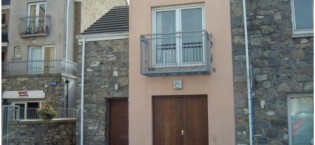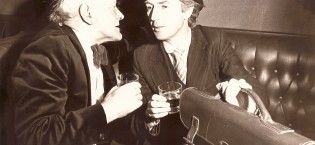Unknown Players Remembered
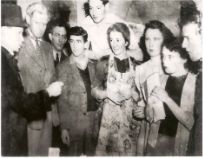 Pádraig Foran, Drama Circle member and former member of the Sligo Unknown Players, details some of the history of “The Unknowns”, as they were more commonly called. Sligo Unknown Players were the forerunner of the Sligo Drama Circle and they experienced a lot of success in the local amateur drama movement. This article also recalls a personal involvement in the local drama movement over the past fifty years.
Pádraig Foran, Drama Circle member and former member of the Sligo Unknown Players, details some of the history of “The Unknowns”, as they were more commonly called. Sligo Unknown Players were the forerunner of the Sligo Drama Circle and they experienced a lot of success in the local amateur drama movement. This article also recalls a personal involvement in the local drama movement over the past fifty years.
Sligo Unknown Players were founded in 1929. They succeeded the Premier Players. Tom Palmer, Writing in The Sligo Champion on the occasion of the retirement of Charlie and Margaret Hughes from the group, remembered his first part. He had just joined the Champion as a cub reporter. The producer at the time was Jim Wynne. He was casting Blind Man’s Buff by the German playwright Ernest Toller. In order to add authenticity to the court scene he cast the young reporter as a court stenographer. Among those taking part in that production was Joe Burns (not the musician) whose reputation survived long after his death. He is commemorated by the Joe Burns Cup for character sketches in Feis Shligigh. Another member of that cast was Ronald Perry who had been a professional actor.
Among the wide variety of plays presented by the Unknowns in the early days were George Bernard Shaw’s Arms and the Man, Professor Tim by George Shiels, Night Must Fall by Emlyn Williams and The Passing Day. But the play which made their name and for which they were remembered for long afterwards was T. C. Murray’s Autumn Fire. Autumn Fire tells the story of Owen Keegan, an elderly widowed farmer who marries a girl half his age. He is crippled while trying to impress his young wife by showing off his strength and vigour. Owen has a son and the inevitable happens – he falls in love with his young stepmother and she with him. The climax of the play comes when Owen, who has gone to bed, appears at the turn of the stairs and finds the young couple kissing in the kitchen. Badly handled, the scene has all the elements of farce.
The part of Owen in the Unknown’s production was played by Alfie Rochford, a Tubbercurry solicitor who in later years became a District Justice. He was a very accomplished actor with a powerful presence and when he appeared at the turn of the stairs you could hear a pin drop in the hall. His performance in Autumn Fire was talked about for many years. Tom Palmer, looking back on the night the Unknowns competed at the Father Matthew Feis, wrote: ”My job was prompter and assistant stage manager and even now I am not ashamed to admit that in that last scene where the broken-hearted Owen slowly fingered his rosary in front of the fading firelight, I lost touch with my prompter’s script for tears filled my eyes”.
Owen’s shrewish sister, Ellen, was played by Margaret Hughes (nee Cahill). Margaret was a great character actress and for many years she was a mainstay of the Unknowns. Tom Palmer again recalled: “Who can ever forget Margaret Hughes as Ellen – a performance that must surely rank among the greats of amateur drama in Ireland”. The young wife was played by Jill Noone. Jill was a teacher in the Ursuline Convent and she was responsible for many productions of Yeats’ plays in Feis Shligigh. Tom Palmer remembered her performance as the Faery Child in The Land of Heart’s desire.
By the time that I became involved with the Unknown Players in 1950, Jim Wynne had retired and Charlie Hughes was the regular producer. Charlie was a Newry man and he was married to Margaret Cahill. Margaret was a teacher and for many years the proceeds of the annual production went to the school where she taught, St. Edward’s National School, Forthill. There was a certain irony in the fact that the proceeds of one night’s performance of the play which marked the fiftieth anniversary of the founding of the Sligo Drama Circle went to the same school.
The Drama Circle came into being as a result of what in political circles would be known as a ‘heave’ against Charlie. ‘Heaves’ and ‘splits’ have been part of amateur drama for as long as I can remember. Among the groups that grew, either directly or indirectly, from the Unknowns were the Bernadette Players, the Drama Circle, Everyman Theatre and Profile Theatre.
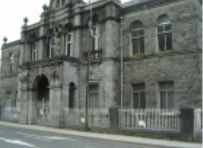 In the 1940’s and early 1950’s most plays were presented in the Gillooly Hall. It had a good stage and adequate, for its time, backstage accommodation. But in terms of audience comfort it left a lot to be desired. The seats were wooden kitchen chairs and the acoustics were not very good especially on the Sunday nights when students were allowed into the end of the hall at a reduced price. Of course people spoke of having a proper theatre. I remember discussing it with, at various times, Tom Mullaney and Eddie Fitzpatrick. But the chances of its happening were very remote.
In the 1940’s and early 1950’s most plays were presented in the Gillooly Hall. It had a good stage and adequate, for its time, backstage accommodation. But in terms of audience comfort it left a lot to be desired. The seats were wooden kitchen chairs and the acoustics were not very good especially on the Sunday nights when students were allowed into the end of the hall at a reduced price. Of course people spoke of having a proper theatre. I remember discussing it with, at various times, Tom Mullaney and Eddie Fitzpatrick. But the chances of its happening were very remote.
My first part with the Unknowns was in Louis Dalton’s comedy “They Got What They Wanted”. The cast consisted of Brendan Cauldwell, Dan Mc Cormack, Gerry Mc Morrow, Eddie Fitzpatrick, Tom Mullaney Eithne Dolan, Margaret Gallagher, Monica Hughes and myself. The produced was Brendan Cauldwell. At this time Brendan was in his early twenties but even then he was an accomplished actor. He played the part of Owen Tubridy, an elderly gombeen man and I remember watching him from the wings. His make-up was so good that he looked sixty and I remember the way he spoke in a whining voice and how he wrung his hands.

Cast of “They Got What They Wanted“, Tubbercurry Drama Festival, 1950.
( L-R) Brendan Cauldwell, Dan McCormack, Gerry McMorrow, Eddie Fitzpatrick, Tom Mullaney, Eithne Dolan, Margaret Gallagher, Monica Hughes and Pauric Foran.
In 1950 someone had the idea of forming a sort of federation of the different drama groups in Sligo. At the time, besides the Unknowns, there were at least three other groups – the Bernadette Players, the C.I.E. Players and the Lough Gill Players. The Bernadette Players were run by Gerry Westby, an accountant with the ESB. He wrote and produced a number of plays and I remember a production of Blithe Spirit which they did. In 1954, to mark the centenary of the apparitions at Lourdes, Gerry wrote and produced a play on the subject. The play was performed over a number of nights at the Holy Well and amongst the cast was a very young Maria Mc Dermottroe in the company of her father Eddie. The CIE Players were made up largely of people who worked in CIE and their friends. Their produced was Joe Fry. George O’ Donnell was producer of the Lough Gill Players who were, I think, associated with the Irish Transport and General Workers’ Union.
The new grouping was rather grandly named Sligo Little Theatre Group. Fr. Tom Hanley, the priest in charge of the Gillooly Hall, was chairman and I was secretary. We had our own headed notepaper printed and we were in business. The plan was that each group would remain autonomous but that they would co-operate in order to try to improve the Gillooly Hall as a venue for drama. Provided they were not cast with their own group, players could take part in another group’s production. (This happened anyway – no-one turned down a good part out of loyalty to his/her own group.) Finally, it was planned that all the groups would combine each year for one production.
The first venture of the Sligo Little Theatre Group involved an outside group. The London Irish Players got in touch with us looking for help in staging two plays in Sligo. We agreed to help with publicity and with props but we made sure that we would get some credit for our work and so the publicity announced that, “The Sligo Little Theatre Group present the London Irish Players in The Chiltern Hundreds.”
The Chiltern Hundreds was staged in the Gillooly Hall on a Sunday Night. I remember spending most of that day searching for some sort of car horn. At that time a man named Holmes who lived in St. Edward’s Terrace used to sell ice-cream from a container which he had fitted on the front of a bicycle. He had one of the old car horns which consisted of a rubber bulb attached to a metal horn. When he squeezed the horn it sounded and let the children know that he was coming. I thought that I could find him and that I could borrow the horn. I didn’t find him, partly because I knew he owned an Alsatian dog which I was not anxious to encounter. However, the lack of a car horn was not the greatest problem that we had. The production had to compete for attention with the consecration of Bishop Vincent Hanley. The London Irish Players seemed to enjoy their stay in Sligo in spite of rather poor audiences. Their producer was G.A. Timoney and he had Sligo connections.
The Little Theatre Group did succeed in mounting one combined production. A photograph which appeared in the Irish Press of March 3rd 1951 shows Brendan Cauldwell, Lottie Bourke, Philomena Beirne and Monica Hughes, in a scene from Jane Eyre. All the local groups came together in 1962 to mark the retirement of Charlie and Margaret Hughes. Walter Mc Donagh produced The Colleen Bawn. The villain, Danny Mann, was played by Michael Feeney. In 1973, the groups again combined, again under the direction of Walter Mc Donagh, to perform a passion play, The Man Born to be King. This was to mark the demolition of the old Dominican church. Tom Mullaney played Christ while Mary Watson was Mary.
The next choice of play spelled disaster for the Little Theatre project. In the 1940’s and 1950’s, one of the biggest objects of devotion was the Dominican Brother, Martin de Porres. He had recently been beatified and each year thousands flocked to Holy Cross church for the annual novena in his honour. A Dominican priest had written a play about Blessed Martin and it was understood that a member of the Holy Cross community intended to organise a production of the play. When a number of months had passed without any news of the production, we began to think that the Dominicans were not interested. We made some enquiries – not enough, unfortunately – and we understood that it would be alright for us to do the play.
We started to prepare for the production when out of the blue we were let know, in no uncertain terms, that the Dominicans felt that it was their play. Some of the committee members were in favour of carrying on but the majority felt that, in the interests of peace, we should withdraw. The Dominicans had a very successful run with the play. John Mullaney played Martin de Porres and Dan Mc Cormack was, as usual, a magnificent archbishop. A few weeks later I got a very caustic letter from Fr. Hilary O’ Neill, Prior of Holy Cross, reminding me that I was a young man and that I had a lot to learn.
The proceeds of most of the plays were given to charity. Sometimes, instead of doing a full-length play we did a one-act. This could be combined with a variety concert to provide a night’s entertainment. For instance, on November 5th, 1950 we performed The Workhouse Ward in the Harrison Hall, Roscommon in aid of the Sisters of Mercy, Roscommon, Chapel Restoration Fund. The concert items were provided by Pearse Gaynor, Jim Gannon, Kay Guinane, Danny Parker, Brendan Cauldwell, Gerry Clynes and Martin Pilkington. The cast of The Workhouse Ward was Brendan Cauldwell, Kay Guinane and myself. Hugh Conway was the accompanist and Vera Sheppard was the violinist while Charlie Hughes was the Master of Ceremonies. On November 15th the same cast performed The Workhouse Ward in the Gillooly Hall in aid of St. Edward’s School Fuel Fund. This time concert items were supplied by The Male Choristers, Kay Guinane, Charles Cunningham, Hugh Conway, Patrick Thornton, Brendan Cauldwell, Val Mc Murray, Jim Gannon, Vera Sheppard, Gerry Clynes and John Mullaney. Hugh Conway was again the accompanist. I often wonder how some of those ‘charity’ events mad any money. Almost invariably, especially if we travelled, we were given a meal by the organisers. Very often a whiskey bottle made its appearance.
Stage sets were generally solid structures and as many of the plays required two or even three changes, the intervals were often long and the audience had to endure a considerable amount of hammering and backstage noise. Lighting was supplied by a row of footlights along the front of the stage and a batten overhead. Sometimes there were one or two spotlights. The lighting was controlled by a dimmer board with four or five dimmers. Care had to be taken that the dimmers didn’t overheat. The lighting was generally fairly simply although I do remember what to me seemed sophisticated lighting effects in one or two plays. Dermot Murphy was usually in charge of lighting while Loman Gallagher acted as stage manager.
Looking back, it’s difficult to compare performances then with performances now. The Drama Festival movement was in its infancy. The ADL summer workshops in places like Gormanstown had not yet begun. There was a drama section in Feis Shligigh but it could only accommodate one-act plays and character sketches. On the other hand, anyone interested had the opportunity of seeing more professional theatre in Sligo than is available today. The great touring companies of Lord Longford and Anew Mc Master were regular visitors to the town while there was sometimes a season of plays in Bundoran. The main emphasis in a production was on the acting rather than on the technical aspects of the staging. Direction was mainly concerned with grouping and making sure that everyone could be seen and heard. The actor was generally left to give his/her own interpretation of the part.
Because all the different companies drew their members from the same pool, it’s not easy to remember who played with whom or, indeed, what plays the different groups did, but there were a number of very good actors available. By the time I came on the scene, Tom Palmer had deserted straight acting and was producing and playing in a very successful annual pantomime with Joe Burns. Aileen Harte and Pauline Flanagan had become professionals and went on to have very successful careers. Paddy Thornton and Eric Koss were better known nationally as singers who broadcast regularly from Raidió Éireann but they were fine actors as was another singer, Pearse Gaynor. I remember Pearse in Boyd’s Shop in the early 1940’s. Eric was an excellent Henry Higgins in Pygmalion. Tom and John Mullaney had done a good deal of acting in Summerhill College under the direction of Fr. Jack Kerrigan. Eddie Fitzpatrick was very enthusiastic but he really came into his own after he returned from Australia and joined the Drama Circle.
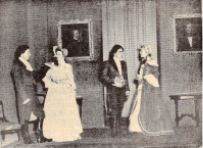
“She Stoops to Conquer“, 1952. (L-R) Paddy Thornton, Mary Watson, John Mullaney, Ann Wehrly
Paddy Dooney, Walter Mc Donagh and Joe Mc Morrow were with the Unknowns before going on to found Sligo Drama Circle. Dan Mc Cormack was an imposing Thomas a Becket in a character sketch from Murder in the Cathedral but I also remember him as Marcy in George Shiels’ The Rugged Path. Eddie Watson played Mr. Hardcastle in She Stoops to Conquer. Mary Watson played his daughter, Kate. Years later they played Mr. And Mrs. Hardcastle in the same play.
In addition to the women I have mentioned, there were several others who come to mind. Kay Guinane was a very versatile actress as was her friend Vera Beazley. Eithne Dolan appeared regularly but I remember her especially as Saint Joan in an extract from Shaw’s play. Mary Mc Govern had the great ability to invent ‘business’ and to make it look entirely natural. Others were Greta Dunleavy, Doreen Tracy, Kitsy Dowling, Kay Raftery, Margaret Gallagher, Noreen Murphy, Thelma and Jacqueline Jinks and Vera Francis.
There were, I am sure, many whose names I have missed. Some of them were before my time, others I have forgotten. They deserve to be remembered because they and their successors made an important contribution to life in Sligo during most of the twentieth century and they are continuing to do so. They provided entertainment to many people and gave them access to a wide variety of theatre which otherwise they would not have experienced. The drama groups gave many young people a means of developing their self-confidence and of displaying their talents. For my own part, I am glad to have been part of the Unknowns and of the other groups and I am grateful to people like Charlie and Margaret Hughes for providing the opportunity. I am also grateful to the many people whose friendship I enjoyed through being involved in drama and music and who have enriched my life over more than half a century.
by Pádraig Foran, November 14th, 2006
Tags: History, Unknown Players


